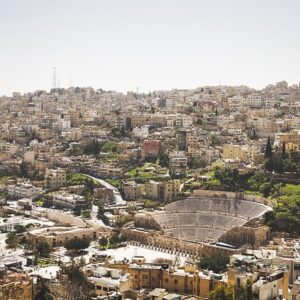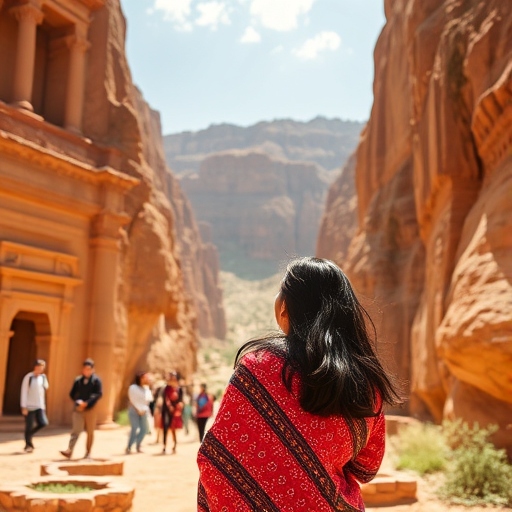"Jordan was an unforgettable experience for me! The moment I saw the Treasury in Petra, I was in awe – it felt like stepping into a different world. The entire journey, from the Roman ruins in Jerash to floating in the Dead Sea, was incredible. We also had an amazing jeep ride in Wadi Rum, and the landscapes were just breathtaking. The people were so warm and welcoming, and I highly recommend visiting Jordan for its rich history and unique beauty!"
- Home
- About Us
- International
- Africa
- America
- Asia
- Australia & New Zealand
- Europe
- Middle East
AfricaEgypt
Mauritius
Zimbabve
AmericaAsiaAustralia & New ZealandEuropeCentral and Eastern Europe
Highlights
Mediterranean Europe
Middle East - Domestic
- North India
- South India
- East and North East
- Rajasthan, West and Central
North IndiaDelhi
Himachal Pradesh
Uttarakhand
Amritsar
Chandigarh
Punjab & Haryana
Uttar Pradesh
South IndiaAndaman and Nicobar Islands
Kerela
Andhra Pradesh
Tamil Nadu
East and North EastAssam
Nagaland
Tripura
Meghalaya
Rajasthan, West and Central - Temple Darshan
- Group Booking
- Blogs
- Contact Us
Sights

Explore Jordan
Jordan is a captivating country in the Middle East, known for its rich history, ancient sites, and stunning landscapes. Home to the iconic Petra, a UNESCO World Heritage Site, Jordan offers a glimpse into the ancient world with its rose-red rock-cut architecture. Visitors can also explore the Dead Sea, known for its unique buoyancy and therapeutic properties, or enjoy the natural beauty of Wadi Rum, a vast desert with striking rock formations. Amman, the capital, blends modernity with history, while Jerash offers impressive Roman ruins. Jordan is a welcoming destination that offers a mix of culture, adventure, and relaxation.
Places You'll See




Tour Highlights
- Well planned Tour itinerary.
- Kitchen as per our own convenience.
- Best hotels through out the tour.
- Unique tour of Scenic Beauty
- Stay in destinations that have proper facilities like hospitals, Market.
- Our groups are scheduled back to back, which is very helpful.
Tour Itinerary
Jordan
Days Plan
- Arrival: Arrive at Queen Alia International Airport, Amman. Transfer to your hotel.
- Morning: After checking in, relax and refresh. You can begin by exploring Amman, Jordan’s bustling capital city.
- Afternoon: Visit the Citadel (Jabal al-Qalaa), where you can explore the ancient ruins and enjoy panoramic views of the city. Explore the Roman Theater in the city center, which dates back to the 2nd century AD.
- Evening: Enjoy a traditional Jordanian dinner at a local restaurant, like Hashem Restaurant, famous for its falafel and hummus.
- Morning: After breakfast, head to Jerash (about 1-hour drive), one of the best-preserved Roman cities in the world. Explore the Roman ruins, including the Oval Plaza, Hippodrome, Temple of Artemis, and Hadrian's Arch.
- Afternoon: After lunch, drive to the Dead Sea (about 1.5 hours), the lowest point on Earth. Relax and float in the mineral-rich waters, known for their therapeutic benefits.
- Evening: Enjoy a relaxing evening at a Dead Sea resort, with the option for a spa treatment, mud bath, or a sunset by the water.
- Morning: After breakfast, depart for Petra (around 3 hours drive). Check in to your hotel upon arrival.
- Afternoon: Begin your exploration of Petra, one of the Seven Wonders of the World. Walk through the Siq, a narrow gorge, leading to the magnificent Treasury (Al-Khazneh), carved into rose-red rock. You can also visit other key sites like the Street of Facades, the Royal Tombs, and the Roman Theater.
- Evening: Consider experiencing Petra by Night, where the Treasury is illuminated by candles for a magical atmosphere (this is available on specific days, usually Mondays, Wednesdays, and Thursdays).
- Morning: After breakfast, explore more of Petra, such as the Monastery (Ad-Deir), a larger and less-visited monument. You can also hike up to the High Place of Sacrifice for panoramic views of the city.
- Afternoon: Depart for Wadi Rum (around 1.5 to 2 hours), also known as the Valley of the Moon. Upon arrival, enjoy a jeep tour of the desert, discovering dramatic rock formations, ancient petroglyphs, and the unique landscapes that have made Wadi Rum famous.
- Evening: Stay overnight in a Bedouin-style camp in Wadi Rum. Enjoy a traditional Bedouin dinner under the stars and perhaps experience a campfire with local music.
- Morning: After breakfast in the desert, head to Aqaba (around 1 hour), Jordan’s only coastal city on the Red Sea.
- Afternoon: Spend the day relaxing at one of the beach resorts in Aqaba or enjoy water activities such as snorkeling, scuba diving, or a glass-bottom boat tour to explore the vibrant coral reefs of the Red Sea.
- Evening: Enjoy a seafood dinner by the beach or visit the Aqaba Fort and the local markets.
Notes:
• 2 passport size photos
• Adult – Original + photocopy of any of the ID proof i.e. Aadhar Card / Driving Licence / Voters ID / Passport
• Child – Original + photocopy of any of the ID proof i.e. Aadhar Card / School ID / Passport
• Infant – Aadhar Card / Birth certificate
• NRI / Foreign nationals – Mandatory Passport + Valid Indian visa / OCI card / PIO card
• Above mentioned ID proof is mandatory at the time of booking and carry the same ID proof on tour as well
Jordan
Tour Details
Hear from Our
Happy Travelers

"I’ve always dreamt of visiting Petra, and my trip to Jordan was everything I imagined and more. Walking through the Siq to see the Treasury for the first time was surreal. Besides Petra, I loved the Dead Sea, where the salty water made floating a fun and unique experience. The local food was delicious, and the hospitality was top-notch. I also explored Amman and visited historical sites like the Citadel and Roman Theater, which were truly fascinating."

"My trip to Jordan was absolutely amazing! From the vibrant markets in Amman to the serenity of Wadi Rum, every moment was magical. The Nabataean tombs in Petra were awe-inspiring, and the Dead Sea was a relaxing experience that I’ll never forget. I also loved the local cuisine, especially mansaf. If you’re a fan of history and adventure, Jordan should be at the top of your list. It was a perfect mix of culture, nature, and adventure."

The best time to visit Jordan is during the spring (March to May) and autumn (September to November) months. Here’s why these periods are ideal:
1. Spring (March to May)
- Weather: Spring in Jordan brings mild and pleasant temperatures, typically ranging from 15°C to 25°C (59°F to 77°F). It’s the perfect time to explore the ancient sites and natural wonders without the extreme heat.
- Landscape: This season offers a beautiful view of the country’s blooming wildflowers and lush greenery, especially in the highlands and around areas like Wadi Rum and Madaba.
- Why Visit: Spring is ideal for sightseeing, hiking, and outdoor activities like trekking in Petra, Wadi Rum, and the Dead Sea, as well as enjoying the ancient ruins.
2. Autumn (September to November)
- Weather: The temperatures in autumn are also mild, ranging from 18°C to 28°C (64°F to 82°F), making it comfortable for exploring Jordan’s historic cities and desert landscapes.
- Why Visit: Autumn provides excellent weather for a more relaxed sightseeing experience, and it’s also harvest season, so you can enjoy fresh local produce and regional foods.
- Tourism: Like spring, autumn sees fewer tourists than in summer, meaning you can avoid long lines at popular sites such as Petra and the Dead Sea.
3. Winter (December to February)
- Weather: Winter in Jordan is cooler, with temperatures ranging from 5°C to 15°C (41°F to 59°F), especially in Amman and the desert areas. However, temperatures can drop significantly at night, and it may even snow in higher elevations like Amman and Ajloun.
- Why Visit: Winter is the off-season, so you’ll find fewer crowds and lower prices. This can be an ideal time for exploring Petra, Jerash, and Aqaba, though it’s better for those who prefer cooler weather or want to enjoy fewer tourists at the popular spots.
4. Summer (June to August)
- Weather: Summer in Jordan can be very hot, especially in the desert regions and in cities like Amman, where daytime temperatures can soar above 35°C (95°F).
- Why Visit: While summer isn’t the best time for sightseeing in the inland areas due to the heat, it’s a great time to visit the coastal city of Aqaba, where the temperatures are more bearable and you can enjoy beach activities, snorkeling, and diving in the Red Sea.
Visiting Jordan is relatively easy and involves a few essential steps for planning your trip. Here’s a guide on how to visit Jordan:
1. Passport and Visa Requirements
- Passport: Ensure your passport is valid for at least 6 months beyond your planned departure date from Jordan.
- Visa:
Indian Citizens: Indian passport holders require a tourist visa to enter Jordan. You can apply for a visa through:
- Jordanian Embassy/Consulate: Apply for a visa before departure.
- Visa on Arrival: If you’re arriving by air at Queen Alia International Airport (Amman), you can obtain a visa on arrival for a stay of up to 30 days. This is usually the most common option for Indian travelers.
- E-Visa: Jordan also offers an e-visa system for some nationalities. You can check if this is available for Indian passport holders on the official Jordanian e-visa website.
Other Nationalities: Nationals of most countries, including the US, EU, and several other countries, can also obtain a visa on arrival or apply for an e-visa depending on their nationality.
2. Flights to Jordan
- Major Airport: The main international gateway to Jordan is Queen Alia International Airport (AMM) in Amman, the capital city.
- Flight Duration:
- Flights from India to Jordan typically take around 5 to 6 hours, depending on your departure city and layovers.
- Airlines: Several airlines operate flights between India and Jordan, including Royal Jordanian, Air India, Emirates, Qatar Airways, and others with layovers in cities like Dubai or Doha.
- Flight Booking: You can book flights directly with airlines or through travel agencies. It’s advisable to book in advance, especially during peak travel seasons (spring and autumn).
3. Getting Around Jordan
- Domestic Flights: For long-distance travel between cities, Jordan has domestic flights, although buses or private cars are often more common.
- Buses:
- Jordan has a well-developed bus network connecting cities like Amman, Aqaba, Petra, and Jerash. Companies like Jett Bus provide comfortable and affordable intercity travel.
- Taxis and Ride-Hailing:
- Taxis are widely available, and you can also use Uber or Careem in cities like Amman.
- Car Rental: Renting a car is a popular option for exploring Jordan at your own pace. It’s recommended if you want to visit remote areas like Wadi Rum or Petra.
- Private Tours: Many visitors opt for guided tours, especially for historical and cultural sites, to make the most of their time and gain insights into the country’s rich heritage.
- Public Transport: Local buses are available in Amman and other cities, but they might not be as frequent or comfortable as taxis or private transportation.
4. Currency and Payment
- Currency: The local currency is the Jordanian Dinar (JOD).
- ATMs: ATMs are widely available in cities and tourist areas.
- Credit Cards: Major credit cards (Visa, MasterCard) are accepted in most hotels, restaurants, and stores in urban areas. However, it’s always good to carry some cash for smaller shops, markets, or remote areas.
- Currency Exchange: You can exchange currency at the airport, banks, or local exchange offices.
5. Best Time to Visit
- Best Months: The best times to visit Jordan are during the spring (March to May) and autumn (September to November). These seasons have mild and pleasant weather, perfect for sightseeing and outdoor activities.
- Winter (December to February) is colder, especially in the highlands, while summer (June to August) can be very hot, especially in desert regions and cities like Amman.
6. Health and Safety
- Vaccinations: Routine vaccinations are recommended, and you may want to consult your doctor about additional vaccines such as Hepatitis A and B and Typhoid.
- Water: Tap water in Jordan is generally safe in major cities but drinking bottled water is recommended, especially for those with sensitive stomachs.
- Safety: Jordan is considered one of the safest countries in the Middle East for tourists. However, always stay informed about the local situation and follow travel advisories.
- Travel Insurance: It is advisable to have travel insurance that covers health, trip cancellations, and lost baggage.
7. Cultural Etiquette
- Dress Modestly: Jordan is a predominantly Muslim country, so it’s advisable to dress conservatively, especially when visiting religious sites. Women should cover their shoulders and knees.
- Respect Religious Sites: When visiting mosques or other religious sites, dress modestly and remove your shoes.
- Tipping: Tipping is customary in Jordan, especially for taxi drivers, hotel staff, and guides. A tip of 5-10% is standard in restaurants.
8. Language
- Arabic is the official language in Jordan, but English is widely spoken, particularly in tourist areas, hotels, and restaurants. Most Jordanians in the service industry can communicate in English, so language is not usually a barrier for tourists.
9. Popular Destinations to Visit in Jordan
- Petra: The famous UNESCO World Heritage site known for its rock-cut architecture and the iconic Treasury (Al-Khazneh).
- Wadi Rum: A stunning desert landscape, also known as the Valley of the Moon, where you can enjoy jeep tours, hiking, and stargazing.
- Dead Sea: The lowest point on Earth, known for its therapeutic waters and mud, which allow you to float effortlessly.
- Amman: The vibrant capital, with ancient sites like the Citadel, Roman Theater, and bustling markets.
- Aqaba: Jordan’s coastal city on the Red Sea, ideal for water sports like diving, snorkeling, and beach relaxation.
- Madaba: Known for its ancient mosaics, including the famous Madaba Map.
10. Local Cuisine to Try
- Hummus: A creamy dip made from chickpeas, tahini, and olive oil.
- Falafel: Deep-fried balls of ground chickpeas, herbs, and spices.
- Mansaf: Jordan’s national dish, consisting of lamb cooked in a yogurt sauce and served with rice.
- Knafeh: A sweet dessert made from cheese, sugar syrup, and phyllo pastry.

Book Now and embark on your next unforgettable adventure
With our team of seasoned travel experts and local guides, we ensure that each trip is crafted to perfection, tailored to your preferences, and filled with unforgettable memories.



